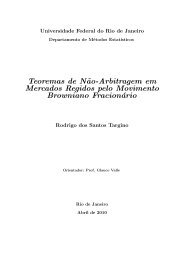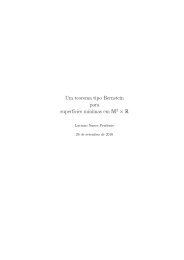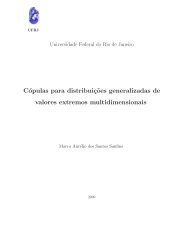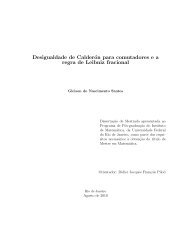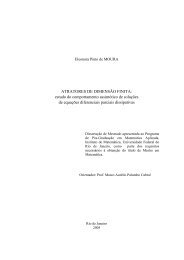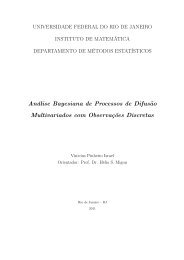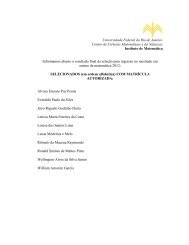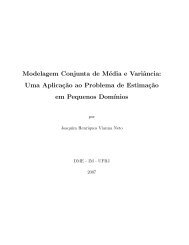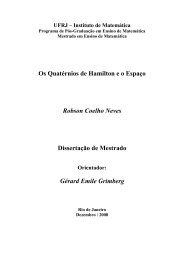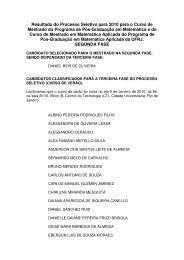Existência, Unicidade e Decaimento Exponencial das Soluç ... - UFRJ
Existência, Unicidade e Decaimento Exponencial das Soluç ... - UFRJ
Existência, Unicidade e Decaimento Exponencial das Soluç ... - UFRJ
You also want an ePaper? Increase the reach of your titles
YUMPU automatically turns print PDFs into web optimized ePapers that Google loves.
Demonstração.<br />
Inicialmente, mostraremos que D(A) é denso em H, em seguida que A e A ∗<br />
são dissipativos e, finalmente, que A é fechado.<br />
1. D(A) é denso em H.<br />
Como D(Ω) = H e D(Ω) ⊂ D(A) ⊂ H, o resultado segue.<br />
2. A e A ∗ são dissipativos<br />
Seja u ∈ D(A)<br />
〈Au, u〉 H×H<br />
=<br />
∫ L<br />
= −<br />
0<br />
∫ L<br />
(Au)udx =<br />
u x udx −<br />
∫ L<br />
0<br />
∫ L<br />
0<br />
0<br />
(−u x − u xxx )udx<br />
u xxx udx = 1 2 u2 x(L) − 1 2 u2 x(0)<br />
= − 1 2 u2 x(0) ≤ 0;<br />
ou seja; A é dissipativo. Agora, observe que se u ∈ D(A) e v ∈ H é<br />
um elemento a ser determinado, teremos que<br />
〈Au, v〉 H×H<br />
=<br />
∫ L<br />
0<br />
= −uv| L 0 +<br />
=<br />
=<br />
∫ L<br />
0<br />
∫ L<br />
(−u x − u xxx )vdx = −<br />
∫ L<br />
0<br />
uv x dx + u x v x | L 0 −<br />
uv x dx − uv xx | L 0 +<br />
∫ L<br />
uv x dx − u xx v| L 0 +<br />
∫ L<br />
0<br />
∫ L<br />
0<br />
u x vdx −<br />
∫ L<br />
0<br />
u x v xx dx<br />
uv xxx dx =<br />
∫ L<br />
0<br />
u xx v x dx<br />
∫ L<br />
0<br />
0<br />
0<br />
u xxx vdx<br />
u(v x + v xxx )dx,<br />
se assumimos que v(0) = v(L) = v x (0) = 0. Portanto, o adjunto de A<br />
é definido por<br />
⎧<br />
A ⎪⎨<br />
∗ w = w ′′′ + w ′<br />
A ∗ : D(A ∗ ) ⊂ H −→ H<br />
⎪⎩ D(A ∗ ) = {w ∈ H 3 (Ω) ∩ H0(Ω); 1 w x (0) = 0}.<br />
30





